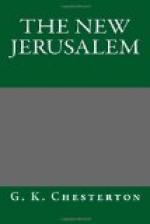And the lions graven over the gate of St. Stephen might well be the text for a whole book on the subject. For if they indicate, however indirectly, the presence of the Latins of the twelfth century, they also indicate the earlier sources from which the Latin life had itself been drawn. The two lions are pacing, passant as the heralds would say, in two opposite directions almost as if prowling to and fro. And this also might well be symbolic as well as heraldic. For if the Crusaders brought the lion southward in spite of the conventional fancy of Moslem decoration, it was only because the Romans had previously brought the lion northward to the cold seas and the savage forests. The image of the lion came from north to south, only because the idea of the lion had long ago come from south to north. The Christian had a symbolic lion he had never seen, and the Moslem had a real lion that he refused to draw. For we could deduce from the case of this single creature the fact that all our civilisation came from the Mediterranean, and the folly of pretending that it came from the North Sea. Those two heraldic shapes over the gate may be borrowed from the Norman or Angevin shield now quartered in the Royal Arms of England. They may have been copied, directly or indirectly, from that great Angevin King of England whose title credited him with the heart of a lion. They may have in some far-off fashion the same ancestry as the boast or jest of our own comic papers when they talk about the British Lion. But why are there lions, though of French or feudal origin, on the flag of England? There might as well be camels or crocodiles, for all the apparent connection with England or with France. Why was an English king described as having the heart of a lion, any more than of a tiger? Why do your patriotic cartoons threaten the world with the wrath of the British Lion; it is really as strange as if they warned it against stimulating the rage of the British rhinoceros. Why did not the French and English princes find in the wild boars, that were the objects of their hunting, the subjects of their heraldry? If the Normans were really the Northmen, the sea-wolves of Scandinavian piracy, why did they not display three wolves on their shields? Why has not John Bull been content with the English bull, or the English bull-dog?




